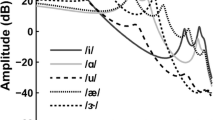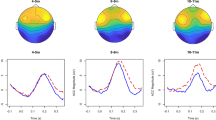Abstract
After entering the peripheral auditory system, a sound undergoes many significant changes. The excitation pattern describes these changes psychoacoustically as inner expression. This study investigates the relations between excitation patterns and their phonetic qualities for Chinese steady-state vowels. First, the peak positions of the envelope of excitation patterns were measured on a database. The results demonstrated that each Chinese vowel has its own special position for the representative peak of the excitation pattern. Second, to examine the sufficiency of these results, a series of experiments that consisted of identification and evaluation tasks were conducted, in which spectral components of natural isolated vowels were manipulated to create certain excitation patterns. Subjects’ responses of these stimuli show that the position of the representative peak of the excitation pattern of a vowel plays a crucial role on its phonetic identity. The results suggest that the phonetic identity of vowels is determined by the position of the representative peak of the excitation pattern evoked by it, and other peaks, if any, do not have phonetic meaning. Additionally, several phenomena about speech perception are discussed on the basis of this study.
Similar content being viewed by others
References
Kuhl P K, Padden D M. Enhanced discriminability at the phonetic boundaries for the place feature in macaques. J Acoust Soc Am, 1983, 73: 1003–1010
Kuhl P K. The special-mechanisms debate in speech research: Categorization tests on animal and infants. In: Harnad S, ed. Categorical Perception: The Groundwork of Cognition. Cambridge: Cambridge University Press, 1987. 355–386
Kuhl P K. Perception of auditory equivalence classes for speech in early infancy. Infant Behav Develop, 1983, 6: 263–285
Pickett J M. The Acoustics of Speech Communication: Fundamentals, Speech Perception Theory, and Technology. Boston: Allyn and Bacon, 1998. 183–197
Zwicker E, Fastl H. Psychoacoustics: Facts and Models. 2nd ed. Berlin, New York: Springer, 1999. 135
Zwicker E. Subdivision of the audible frequency into critical bands. J Acoust Soc Am, 1961, 33(2): 248
Zwicker E. Masking and psychological excitation as consequences of ear’s frequency analysis. In: Plomp R, Smoorenburg G F, eds. Frequency Analysis and Periodicity Detection in Hearing. Leiden: Sijthoff, 1970
Bladon R A W, Lindblom B. Modeling the judgment of vowel quality differences. J Acoust Soc Am, 1981, 69(5): 1414–1422
Syrdal A K, Gopal H S. A perceptual model of vowel recognition based on the auditory representation of American English vowels. J Acoust Soc Am, 1986, 79: 1086–1100
de Cheveigné A, Kawahara H. Missing data model of vowel perception. J Acoust Soc Am, 1999, 105: 3497–3508
Molis M R. Evaluating models of vowel perception. J Acoust Soc Am, 2005, 118(2): 1062–1071
Houtgast T. Auditory analysis of vowel-like sounds. Acustica, 1974, 31: 320–324
Tyler R S, Lindblom B. Preliminary study of simultaneous masking and pulsation threshold patterns of vowels. J Acoust Soc Am, 1982, 71: 220–224
Moore B C J, Glasberg B R. Suggested formulae for calculating auditory-filter bandwidths and excitation patterns. J Acoust Soc Am, 1983, 74: 750–753
Sachs M B, Young E D. Encoding of steady-state vowels in the auditory nerve: Representation in terms of discharge rate. J Acoust Soc Am, 1979, 66(2): 470–479
Young E D, Sachs M B. Representation of steady state vowels in the temporal aspects of the discharge patterns populations of auditory nerve fibers. J Acoust Soc Am, 1979, 66: 1381–1403
Sachs M B, Young E D, Miller M I. Encoding of speech features in the auditory nerve. In: Carlson R, Granstrom B, eds. The Representation of Speech in the Peripheral. Amsterdam: Elsevier, 1982. 115–130
Chistovich L A, Lublinskaja V V. The center of gravity effect in vowel spectra and critical distance between the formants. Hear Res, 1979, 1: 185–195
Chistovich L A, Sheikin R L, Lublinskaya V V. ’Centers of gravity’ and the spectral peaks as the determinants of vowel quality. In: Lindblom B, Ohman S, eds. Frontiers of Speech Communication Research. London: Academic, 1979. 143–157
Traunmüller H. Perception of timbre: evidence for spectral resolution bandwidth different from critical band? In: Carlson R, Granstrom B, eds. The Representation of Speech in the Peripheral. Amsterdam: Elsevier, 1982. 103–108
Delattre P C, Liberman A M, Cooper F S, et al. An experimental study of the acoustic determinants of vowel color: observations on one- and two-formant vowels synthesized from spectographic patterns. Word, 1952, 8: 195–210
Chistovich L A. Center auditory processing of peripheral vowel spectral. J Acoust Soc Am, 1985, 77: 789–805
Nearey T M. Static, dynamic, and relational properties in vowel perception. J Acoust Soc Am, 1989, 85: 2088–2113
Engelhardt V, Gehrcke E. Vokalstudien. eine akustischpsychologische Experimentaluntersuchung uber Voleale, worte and Stze. Leipzig: Barth, 1930
Farnsworth P R. An approach to the study of vocal resonance. J Acoust Soc Am, 1937, 9: 152–155
Klatt D H. Speech processing strategies based on auditory models. In: Carlson R, Granstrom B, eds. The Representation of Speech in the Oerioheral Auditory System. Amsterdam: Elsevier, 1982. 181–196
Maddieson I. Patterns of Sounds. Cambridge: Cambridge University Press, 1984
Carlson R, Granstrom B, Fant G. Some studies concerning perception of isolated vowels. Quarterly Progress Status Reports STL-QPSR 2/3, Speech Transmission Laboratory. 1970
Author information
Authors and Affiliations
Corresponding author
Additional information
Supported by the “211 Key Projects” of Communication University of China
Rights and permissions
About this article
Cite this article
Yu, S. Excitation patterns and phonetic identities of Chinese vowels. Sci. China Ser. F-Inf. Sci. 52, 1936–1946 (2009). https://doi.org/10.1007/s11432-009-0164-z
Received:
Accepted:
Published:
Issue Date:
DOI: https://doi.org/10.1007/s11432-009-0164-z




